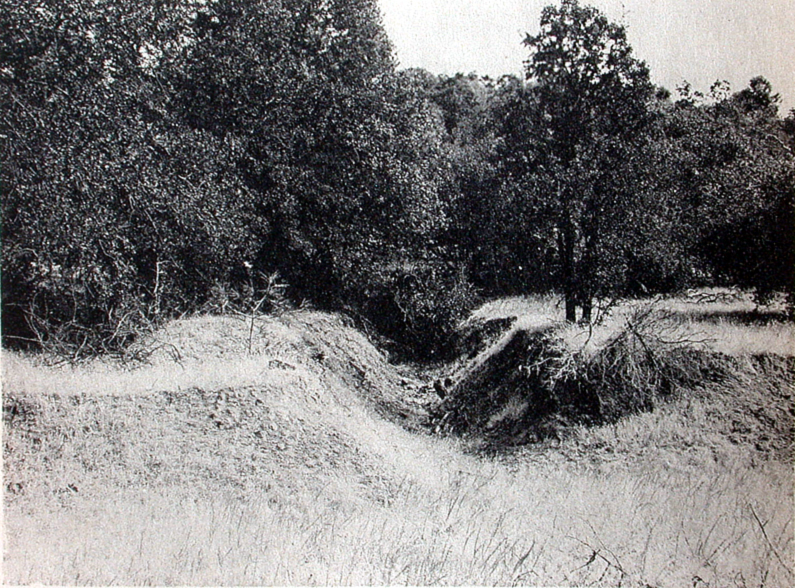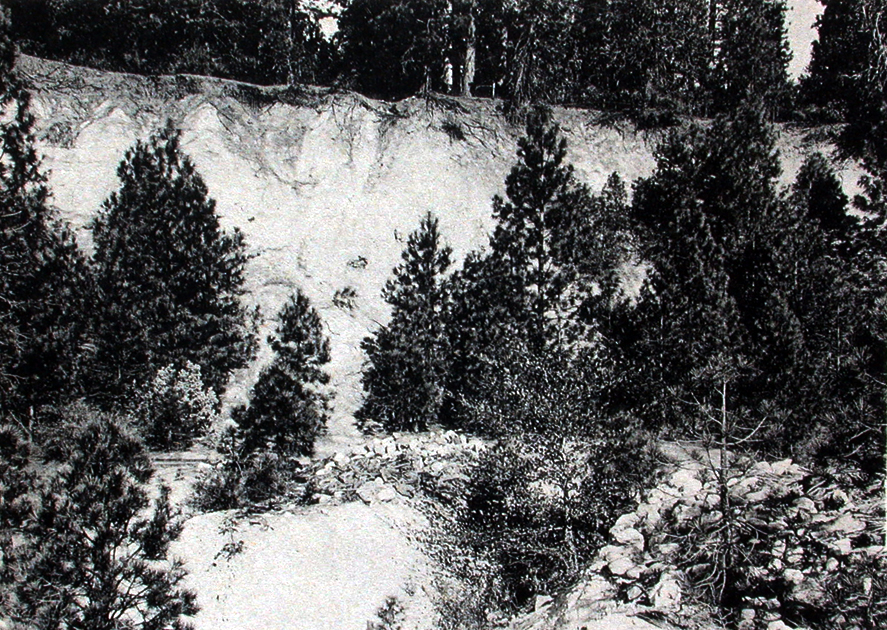


|
Top and bottom--Two archival photographs of classic fossil leaf localities in the late Miocene Mehrten Formation--one of three famous Tertiary Period fossil plant-bearing rock formations one can examine in California's Gold Country, western foothills of the Sierra Nevada, along the route to the Disaster Peak Formation plants in the High Sierra Nevada, Alpine County; the other two are the middle Eocene Ione Formation and the late Oligocene to lower Miocene Valley Springs Formation. Both photographs taken during the early 1940s; courtesy a specific scientific publication. Two supplemental areas in the California's High Sierra Carson Pass region--east of Jackon (county seat of Amador County)--also yield Tertiary-age petrified wood and fossil leaves from two unnamed (in the published scientific literature) geologic rock formations of middle Miocene age. Top--The late-middle Mehrten Formation fossil leaf-bearing site (about 10 million years old) near Columbia State Park, California, about 26 miles south of Angels Camp (convenient turnoff point for the Disaster Peak Formation paleobotanical site)--an old gold prospect currently on private property, marked by the prominent excavation. Some 28 species of Miocene plants have been identified from this locality, including Chinese maple, laurel sumac, American holly, Mexican grapeholly, Oregon grape, Pagoda dogwood, Black tupelo, Pacific madrone, Chinese rhododedron, extinct Asiatic oak (first specimen discovered at the Pliocene-age Petrified Forest in Sonoma County, California), Engelmann oak, coastal sage scrub oak, Bitternut hickory, swampbay, California bay, Eastern redbud, New Mexico locust, Southern magnolia, Desert olive, Western sycamore, Alabama supplejack, Mountain mahogany, Chinese hawthorn, Brewer's willow, Lewis' mock-orange, western hackberry, American elm, and Knobcone pine. Bottom--This is the early-late Mehrten Formation leaf-yielding locality (9.5 million years old) several miles east of Nevada City/Grass Valley (they are contiguous communities), northern Mother Lode country, about 85 miles north of Angels Camp (the turnoff point for the Disaster Peak Formation fossil plant-bearing area). The paleobotanic bonanza occurs along the cliff face, originally exposed by hydraulic gold miners in the mid 1850s. A gold nugget from this area, by the way, weighed in at 11.6 pounds, making it the 22nd heaviest gold nugget ever discovered in California. 32 species of late Miocene plants have been identified from this Mehrten locality east of Nevada City/Grass Valley, including: Port orford cedar (not really a cedar, of course, but rather a cypress); Coast redwood; Boxelder maple; an extinct species of Mahonia (barberry); oval-leaved viburnum; Pacific madrone; manzanita; Sierra laurel; Blue oak; Valley oak; California black oak; Oracle oak; an extinct oak similar to the extant Chinese evergreen oak; Oriental white oak; Interior live oak; American sweetgum; Ohio buckeye; Eastern black walnut; Red bay; California bay; roundleaf greenbrier; Western sycamore; Alabama supplejack; Buckbrush; mountain hawthorn; Hollyleaf cherry; Black cottonwood; Quaking aspen; Fremont cottonwood; Shining willow; Mexican buckeye; American elm; an extinct species of grapevine. |